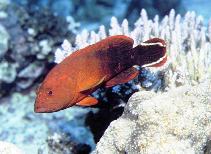
|
Cephalopholis urodeta (Forster, 1801) Darkfin hind |
||
| Flag-tailed grouper, Lapu-lapu, Abo-abo, Alatan, Bantol, Baraka, Bato-bato, Batol, Flagtail rockcod, Iner, Inid, Jahong, Kakab, Kaltang, Kigting, Kugtong, Kugtung, Kulapo, Kurapo, Labungan, Lapu-lapu, Lapu-lapung lupot, Lilug, Lubo, Mamonbong, Maskad, Matkad, Ogaw, Pugapo, Pugayo, Salingukod, Sibog, Sigapo, Subla, Suno, Tabadlo, Tangk-an, Ting-ad, Vahatan | ||

|
|
photo by
Patzner, R. |
| Family: | Epinephelidae (Groupers) | |||
| Max. size: | 28 cm TL (male/unsexed) | |||
| Environment: | reef-associated; marine; depth range 0 - 60 m | |||
| Distribution: | Pacific Ocean: eastward to French Polynesia and the Pitcairn Islands, and to Christmas Isalnd in the Indian Ocean | |||
| Diagnosis: | Dorsal spines (total): 9-9; Dorsal soft rays (total): 14-16; Anal spines: 3-3; Anal soft rays: 8-9. This species is distinguished by the following characteristics: greatest body depth 2.7-3.1 in standard length; body scales ctenoid except cycloid scales ventrally on abdomen; rounded caudal fin; pelvic fins usually not reaching the anus, 1.8-2.2 in head length Colour of body reddish brown anteriorly, dark brown posteriorly; caudal fin with 2 white to bluish white bands that converge posteriorly (Ref. 90102). | |||
| Biology: | Adults inhabit clear, shallow waters of outer reef areas, in lagoons, back-reef areas, and on the reef-top. As solitary individuals (Ref. 90102), they prefer healthy coral reef in shallow areas, and are therefore greatly affected by reef degradation (Ref. 89707). They feed on small fishes (68%) and crustaceans. Because of its small size, the darkfin hind is not of much interest as a food fish (except perhaps to subsistence fisheries), but it does well in an aquarium and may find a market as an aquarium fish. They are caught with hook-and-line, gill nets, and in traps (Ref. 39231). Minimum depth reported taken from Ref. 128797. | |||
| IUCN Red List Status: | Least Concern (LC); Date assessed: 15 November 2016 Ref. (130435) | |||
| Threat to humans: | harmless | |||
| Country info: | Recorded in Tañon Strait (Ref. 107276). Known from Surigao City (Ref. 58652) and Lanuza Bay (Ref. 104756), Nasugbu, Batangas (Ref. 107854), Bongo Island and Paril-Sangay Protected Seascape, Moro Gulf (Ref. 106380). Museum: Palawan, Puerto Princesa City, USNM 226801. Jolo, SU 27520. Also Ref. 4787, 5222, 48613, 53416, 59110, 090102, 107853, 121724. | |||